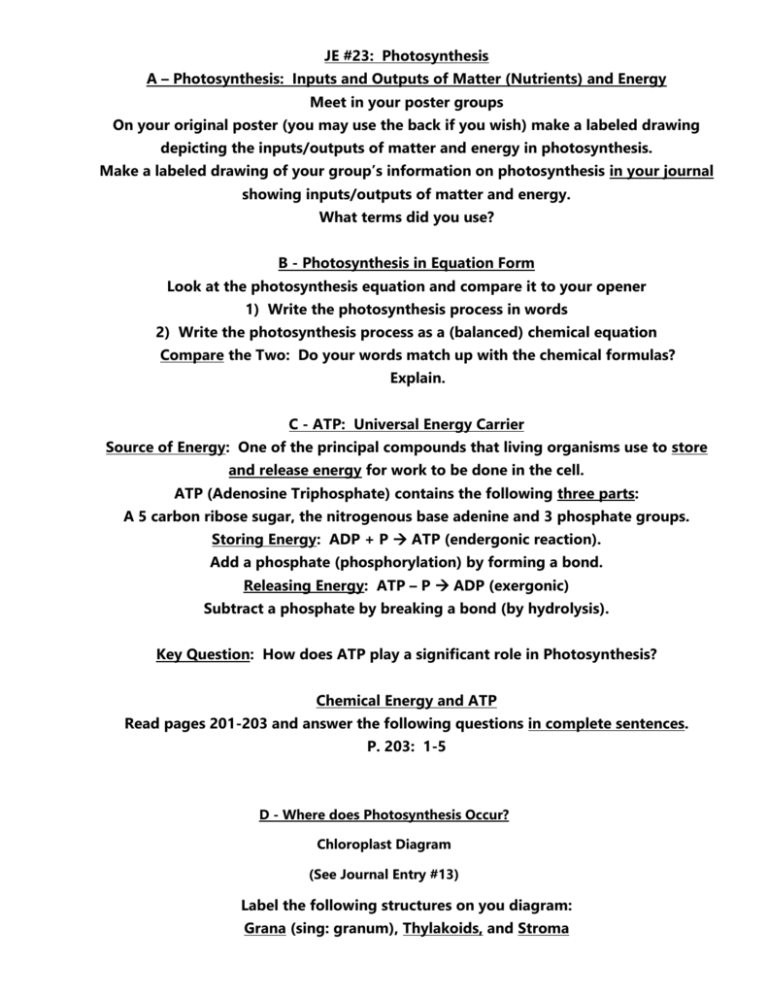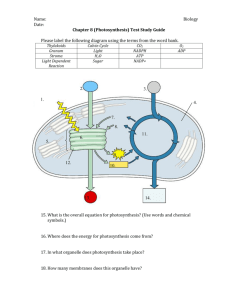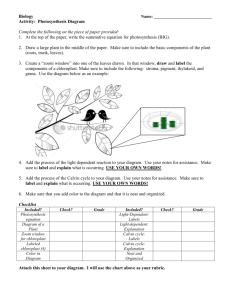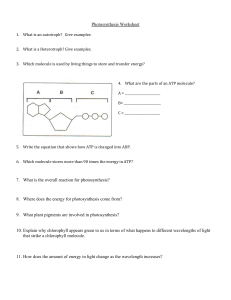JE #23: Photosynthesis A – Photosynthesis: Inputs and Outputs of
advertisement

JE #23: Photosynthesis A – Photosynthesis: Inputs and Outputs of Matter (Nutrients) and Energy Meet in your poster groups On your original poster (you may use the back if you wish) make a labeled drawing depicting the inputs/outputs of matter and energy in photosynthesis. Make a labeled drawing of your group’s information on photosynthesis in your journal showing inputs/outputs of matter and energy. What terms did you use? B - Photosynthesis in Equation Form Look at the photosynthesis equation and compare it to your opener 1) Write the photosynthesis process in words 2) Write the photosynthesis process as a (balanced) chemical equation Compare the Two: Do your words match up with the chemical formulas? Explain. C - ATP: Universal Energy Carrier Source of Energy: One of the principal compounds that living organisms use to store and release energy for work to be done in the cell. ATP (Adenosine Triphosphate) contains the following three parts: A 5 carbon ribose sugar, the nitrogenous base adenine and 3 phosphate groups. Storing Energy: ADP + P ATP (endergonic reaction). Add a phosphate (phosphorylation) by forming a bond. Releasing Energy: ATP – P ADP (exergonic) Subtract a phosphate by breaking a bond (by hydrolysis). Key Question: How does ATP play a significant role in Photosynthesis? Chemical Energy and ATP Read pages 201-203 and answer the following questions in complete sentences. P. 203: 1-5 D - Where does Photosynthesis Occur? Chloroplast Diagram (See Journal Entry #13) Label the following structures on you diagram: Grana (sing: granum), Thylakoids, and Stroma (Notes) Chloroplasts are made up of Grana (sing: granum) where the Light Dependent Reactions (LDR’s) take place and stroma, where the Calvin Cycle takes place. Grana are made up of structures called thylakoids. Thylakoids contain chlorophyll that absorbs light energy. See P. 207 (Fig. 8-5) and answer the following questions in complete sentences: 1) Chlorophyll (a and b) absorbs light in what wavelengths? 2) What happens to the light in the green wavelengths? E – The Light Dependent Reactions of Photosynthesis Fill in the missing information on your Chloroplast diagram. Look at Part B (Photosynthesis equation) for the answer. 1) Write the Photosynthesis Equation: Circle the parts of the equation which are involved in the LDR’s (see your Chloroplast Diagram) 2) 2H2O 4H + O2 Water molecules are split by the light energy (think of Chemistry Unit and Life Occurs in Water and Water Lab) 3) What happens to the oxygen? The oxygen is released to the atmosphere 4) What happens to the Hydrogen? (See your Chloroplast Diagram) H+ ions are used to energize (NADP+ H+ NADPH) and provides the energy to make ATP from ADP + P (storing or releasing energy?) This is made possible by the electron transport chain which transports H+ ions from the stroma to the inner thylakoid membranes. 5) ATP and NADPH from the light dependent reactions are used to make sugars in the Calvin Cycle. How will ATP and NADPH release their energy to the Calvin Cycle? F – The Calvin Cycle of Photosynthesis Calvin Cycle Penny Activity Copy the Calvin Cycle Diagram 8-11 on p. 212 Copy only C’s , arrows, ATP/ADP’s, NADPH/NADP+ and blue headings (A-D) Not the text under the blue headings. Show the cycle with the (36) Pennies – heads are “energized” and tails are not Be prepared to pass a verbal quiz You will need Mr. Ogren’s signature for Parts E and F.









